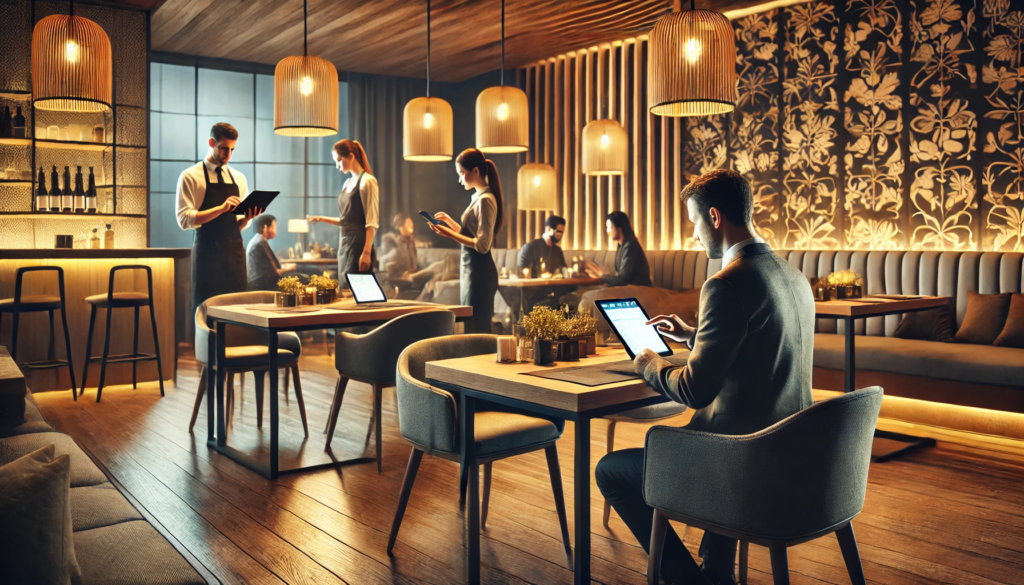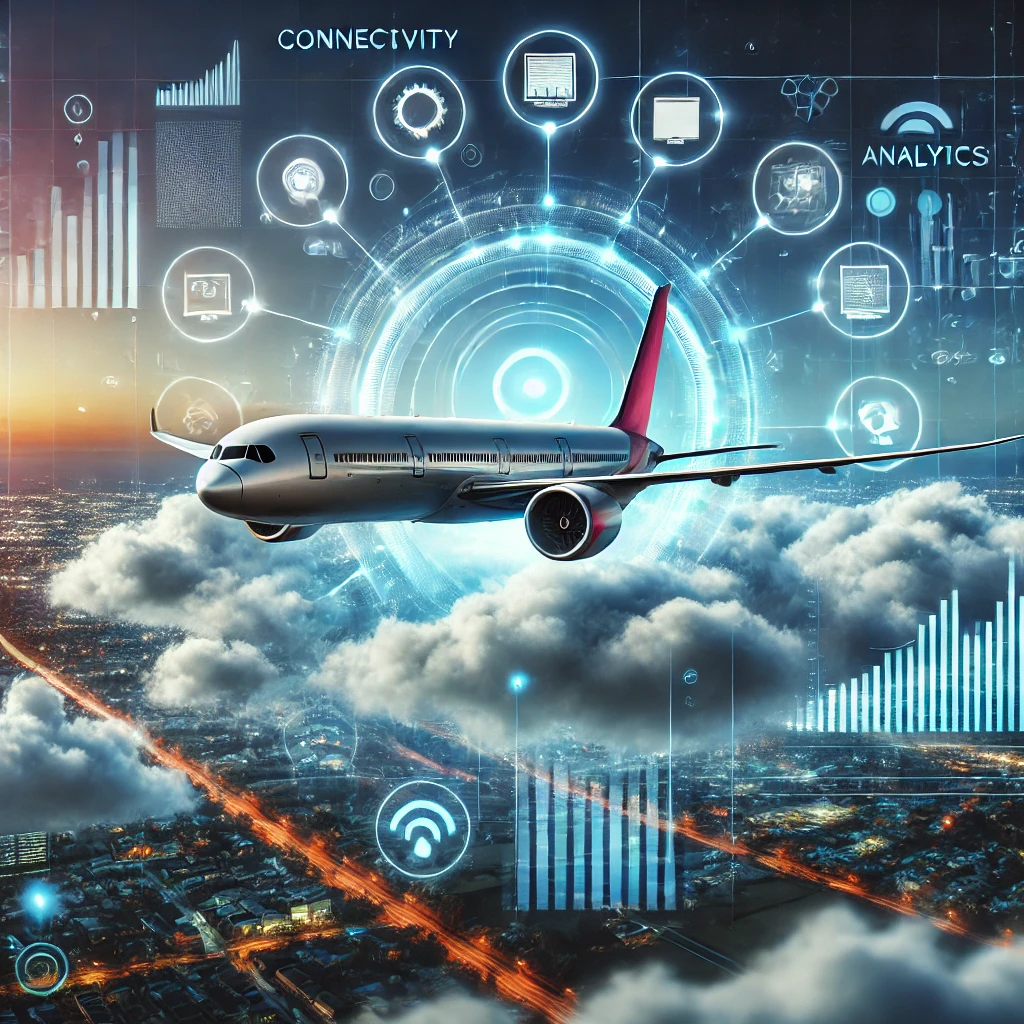
The restaurant industry is undergoing a significant digital transformation, driven by evolving consumer preferences, economic pressures, and technological advancements. As we move through 2024, restaurants are increasingly leveraging digital tools to enhance operational efficiency, improve customer experiences, and drive business growth. This transformation is not just a trend but a necessity for survival and competitiveness in the modern market.
Digital transformation in the restaurant sector encompasses a wide range of technologies and strategies. These include online ordering systems, mobile apps, digital menus, point-of-sale (POS) systems, and data analytics. The goal is to integrate these technologies seamlessly into restaurant operations to create a more efficient, customer-centric business model.
One of the most notable trends is the rise of online food delivery. According to Statista, the global online food delivery market is projected to grow from $130.2 billion in 2023 to $223.7 billion by 2027. This growth is fueled by the increasing consumer demand for convenience and the proliferation of third-party delivery platforms like DoorDash, UberEats, and GrubHub.
Another critical aspect of digital transformation is the adoption of contactless payment systems. The pandemic accelerated the shift towards contactless transactions, and this trend is expected to continue. According to Juniper Research, approximately 53% of global transactions running through POS systems will be contactless by 2025.
Moreover, restaurants are investing in advanced POS systems and customer relationship management (CRM) tools to streamline operations and enhance customer engagement. These technologies enable restaurants to manage orders, payments, and inventory more efficiently while providing personalized experiences to customers based on their preferences and behaviors.
The integration of artificial intelligence (AI) and automation is also transforming the restaurant landscape. AI-powered chatbots, for instance, are being used to handle customer inquiries and reservations, while automation tools are helping to optimize staffing and inventory management. According to a KPMG report, many restaurants are still in the early stages of their AI journeys but are beginning to identify significant opportunities for future investment.
In conclusion, the digital transformation of the restaurant industry is reshaping how businesses operate and interact with customers. By embracing these technological advancements, restaurants can enhance their efficiency, improve customer satisfaction, and position themselves for long-term success in an increasingly competitive market. As we delve deeper into 2024, staying ahead of these trends will be crucial for any restaurant looking to thrive in the digital age.
Table of Contents
- Key Trends in Restaurant Technology for 2024
- Technology Integration in Restaurant Operations
- Automation and Robotics
- Artificial Intelligence and Data Analytics
- Personalized Dining Experiences
- Sustainability and Eco-Friendly Practices
- Experiential Dining
- Benefits of Digital Transformation in Restaurants
- Increased Efficiency
- Enhanced Customer Experience
- Data-Driven Insights
- Competitive Advantage
- Cost Savings
- Overcoming Common Challenges
- Continuous Improvement
- Case Studies
- Best Practices for Implementing Digital Solutions
- Streamlining Tech Ecosystems
- Prioritizing Payment Methods
- Menu, Product Page Restructure & Redesign
- Expanding Geolocation Capabilities
- Improving Platform Security
- Embracing the Future: Implementing New Technology
- Digital Transformation Case Studies
- The Growing Importance of Digital Marketing
- Online Reservations, Ordering & Table Service
- The Emergence of Virtual Reality
Key Trends in Restaurant Technology for 2024
Technology Integration in Restaurant Operations
One of the most significant trends in the restaurant industry is the increasing integration of technology into various operations. From digital menus and contactless ordering to advanced point-of-sale systems, technology is streamlining processes and enhancing the overall dining experience. Mobile apps allow customers to place orders, make reservations, and even pay for their meals seamlessly. Artificial intelligence (AI) and data analytics are used to personalize menus and promotions based on customer preferences, creating a more engaging and efficient dining experience (Forbes).
Additionally, the rise of virtual kitchens and ghost restaurants, fueled by the growth of online food delivery services, is transforming the traditional restaurant model. These establishments operate without a physical storefront, focusing solely on fulfilling orders through delivery apps. This trend is reshaping the industry’s dynamics, presenting challenges and opportunities for restaurateurs (Forbes).
Automation and Robotics
Automation is becoming a cornerstone in restaurant operations. Sweetgreen, for instance, has opened its first Infinite Kitchen in Illinois and plans to add several new units in 2024. The automated kitchen has offered several benefits, including increased throughput, near-perfect order accuracy, portioning consistency, a better team member experience, improved restaurant-level margins, and an accretive return on capital. The automated makeline dispenses ingredients into bowls at the rate of 500 per hour while workers do the prep and add finishing touches, saving costs on labor and ensuring quality control (Food Institute).
Broader rollouts of store-based robots, such as Simbe/Tally, as well as shelf-edge labels and cameras, are expected to become industry standards for major players. These technologies are anticipated to replace traditional methods like paper circulars with mobile-based coupons and over time, end-cap screens, shelf-edge screens, and other display media (Food Institute).
Artificial Intelligence and Data Analytics
AI is playing an increasingly critical role in the restaurant industry. According to Deliverect data, 46% of consumers globally report being comfortable with the idea of robots carrying out certain functions in restaurants. AI is expected to help with menu optimization, streamlining food preparation, and creating more personalized customer experiences (Food Institute).
Valerie Gong from Boston Consulting Group emphasized AI as a fundamental catalyst for growth in the digital foodservice space. She noted that 56% of customers expect offers to be personalized, 73% expect companies to understand their unique needs and expectations, and 62% expect companies to anticipate customer needs (Food Institute).
Personalized Dining Experiences
The demand for personalized dining experiences is rising, with consumers expecting restaurants to cater to their individual preferences. Technology is crucial in this trend, as data analytics enable restaurants to understand customer behavior and tailor offerings accordingly. Customization options, such as build-your-own menus and personalized recommendations based on past orders, are becoming more common. This trend extends beyond the menu to include customized marketing messages and loyalty programs, creating more engaging relationships between the restaurant and its guests (Forbes).
Sustainability and Eco-Friendly Practices
As environmental consciousness grows, sustainability has become a significant focus for the restaurant industry. Restaurant customers are increasingly focused on the ecological impact of their choices, and restaurants are responding by adopting eco-friendly practices. This includes sourcing organic and local ingredients, controlling food waste, and employing energy-efficient measures (Forbes).
Many restaurants are embracing plant-based and vegetarian options to cater to the growing demand for these choices and as a commitment to sustainability. The use of eco-friendly packaging materials and efforts to minimize carbon footprints are becoming integral parts of a restaurant’s branding strategy. In 2024, sustainability is not just a trend; it’s a necessity that aligns with consumer values and expectations (Forbes).
Experiential Dining
Beyond serving delicious food, restaurants are increasingly focusing on creating unique and memorable dining experiences. Experiential dining goes beyond the traditional meal concept, encompassing everything from immersive themes and interactive elements to entertainment and storytelling. Pop-up restaurants, themed dining events, and chef collaborations are gaining popularity, allowing customers to taste the culinary world in new and exciting ways. Social media user reviews and influencers amplify these experiences as customers share their unique dining adventures, contributing to the restaurant’s marketing efforts (Forbes).
Conclusion
The restaurant industry in 2024 is navigating a landscape shaped by technological advancements, sustainability imperatives, and changing consumer expectations. Technology integration, a focus on sustainability, experiential dining, health-conscious choices, and personalized experiences are key trends driving this transformation. As restaurants adapt to these changes, they have the opportunity to meet customer demands and differentiate themselves in a competitive market. The successful restaurant of the future will embrace innovation, prioritize sustainability, and deliver exceptional and personalized dining experiences (Forbes).
Benefits of Digital Transformation in Restaurants
Increased Efficiency
Digital transformation (DT) significantly enhances operational efficiency in restaurants by automating various manual processes. For instance, digital ordering systems streamline the order-taking process, reducing errors and improving order accuracy. This automation allows staff to focus on higher-value tasks, such as customer service, thereby enhancing the overall dining experience (source).
Moreover, inventory management systems can track stock levels in real-time, helping restaurants manage their inventory more efficiently and reduce waste. This real-time tracking ensures that restaurants can maintain optimal stock levels, preventing both overstocking and stockouts (source).
Enhanced Customer Experience
Today’s consumers expect convenience and personalization, and DT enables restaurants to meet these expectations. Online ordering systems and mobile apps allow customers to place orders quickly and easily, reducing wait times and improving the overall dining experience. Additionally, digital tools enable restaurants to offer personalized menu suggestions and promotions based on customer preferences and behavior (source).
For example, a restaurant can use data analytics to identify popular dishes and feature them more prominently on their website or app. Similarly, if customers frequently request a specific modification, the restaurant can add it as an option, thereby enhancing customer satisfaction (source).
Data-Driven Insights
One of the most significant benefits of DT is the ability to gather and analyze customer data. By tracking metrics such as online sales, customer preferences, and feedback, restaurants can gain valuable insights into customer behavior. These insights enable restaurants to make informed decisions about menu offerings, specials, and promotions, ultimately leading to increased customer satisfaction and loyalty (source).
For instance, data analytics can help restaurants tailor their marketing efforts to target specific customer segments more effectively. By understanding customer preferences and trends, restaurants can develop more effective marketing strategies and continuously improve the overall dining experience (source).
Competitive Advantage
Embracing DT provides restaurants with a competitive edge by enabling them to offer a superior customer experience and streamlined operations. Restaurants that leverage digital solutions can attract and retain more customers, thereby increasing their market share. Additionally, DT allows restaurants to stay ahead of industry trends and adapt to changing consumer expectations (source).
For example, a restaurant that implements a digital ordering and payment system can significantly reduce wait times and improve order accuracy, leading to higher customer satisfaction and repeat business. Similarly, a loyalty program integrated with a mobile app can increase customer retention rates and average order value (source).
Cost Savings
While implementing digital solutions may require an initial investment, the long-term cost savings can be substantial. Automation of certain tasks can reduce the need for manual labor, lowering overall labor costs for restaurants. Additionally, smart technology can help restaurants reduce energy consumption, leading to lower utility bills (source).
For instance, a smart inventory management system can optimize inventory levels, reducing food waste and improving kitchen efficiency. This optimization leads to significant cost savings and increased profitability for the restaurant (source).
Overcoming Common Challenges
Implementing DT in a restaurant setting can come with challenges, such as limited budget and integration issues with existing systems. However, these challenges can be overcome with careful planning and execution. For example, restaurants can start with small steps towards digitalization, such as implementing cloud-based solutions with low monthly fees and no upfront investment (source).
Additionally, choosing digital solutions that integrate seamlessly with existing systems can minimize integration issues. Testing new tools from beginning to end before rolling them out and having a plan in place to address any issues that arise can further mitigate these challenges (source).
Continuous Improvement
DT is an ongoing process, not a one-time event. Once new solutions are implemented, it is essential to track their performance and make adjustments as needed. Using data analytics to monitor key metrics, such as online sales and customer feedback, can help restaurants identify areas for improvement and optimize their digital strategy (source).
For example, if a particular digital tool is not performing as expected, restaurants can analyze the data to understand the underlying issues and make necessary adjustments. This continuous improvement approach ensures that restaurants can adapt to changing consumer expectations and stay competitive in the ever-evolving restaurant industry (source).
Case Studies
Real-world case studies demonstrate the tangible benefits of implementing digital smart restaurant technology. For instance, Restaurant A, a popular chain with multiple locations, faced challenges with long wait times, order errors, and inefficient kitchen operations. By implementing a digital ordering and payment system, the restaurant significantly reduced wait times, improved order accuracy, and streamlined kitchen operations, leading to increased customer satisfaction and revenue (source).
Similarly, Restaurant B, a family-owned diner, launched a loyalty program integrated with a mobile app to improve customer engagement and loyalty. The program increased customer retention rates and average order value, leading to higher customer satisfaction and repeat business (source).
In another example, Restaurant C, a high-end fine dining establishment, implemented a smart inventory management system and kitchen automation technology. The new system reduced food waste, optimized inventory levels, and improved kitchen efficiency, resulting in significant cost savings and increased profitability (source).
These case studies highlight the various ways in which digital smart restaurant technology can enhance operations, improve customer satisfaction, and drive business growth in today’s competitive dining industry.
Best Practices for implementing Digital Solutions
Streamlining Tech Ecosystems
Brands are increasingly recognizing that the platforms and systems implemented before and during the pandemic may no longer meet their evolving business needs. A comprehensive re-evaluation of the entire tech stack—from back-of-house systems to mobile apps and websites—is essential. The goal is to restructure technical ecosystems for efficiency and adaptability, which can help conserve costs and ensure that platforms effectively meet larger business goals.
Successful brands often partner with organizations that continuously reinvest in their platform technology and provide hands-on support to restaurant marketing and IT teams. This collaboration maximizes the platform’s impact and value (Bounteous).
Prioritizing Payment Methods
As brands evolve their 2024 program goals to emphasize revenue and conversion, rethinking the checkout process within the digital experience is a high-impact and obvious place to start. Many apps lack support for convenient payment methods that speed up order placement, leading users to replace their saved credit cards with digital wallet options like Apple Pay, Google Pay, PayPal, and Venmo. Some leading brands report that upwards of 30% of their orders are placed using digital wallets (Bounteous).
Menu, Product Page Restructure & Redesign
The pandemic forced many brands to focus on supporting store operators’ needs, causing front-end, user-facing digital experiences to take a back seat. Now, brands recognize the need to refresh their menu UX and UI to catch up with industry and user expectations. High-impact initiatives include rich product and modifier imagery, streamlined item customization, personalized upsell recommendations, and actionable prompts and visual aids to guide users when they make errors (Bounteous).
Expanding Geolocation Capabilities
The rapid shift to digital ordering during the pandemic has resulted in the availability of rich user behavioral data. Integrated geolocation capabilities like geofencing and triggered location-based messaging can streamline and enhance the user’s end-to-end experience. Brands can use these services to drive users to order in new and evolved ways, aligning with their business strategies and operations (Bounteous).
Improving Platform Security
Malicious behavior has increased dramatically in the past two years, posing a serious threat to both users’ personal information and brand P&Ls. According to Cisco’s Consumer Privacy Survey (2022), 81% of users believe the way a company treats their personal data is indicative of how it views them as a customer. Therefore, CIOs and CTOs are expected to focus on improving digital ecosystem security in 2024. This often starts with back-end improvements like app hardening, tighter Cloudflare standards, and third-party identity management platforms (Bounteous).
Embracing the Future: Implementing New Technology
The beginning of the year is an opportune time for restaurants to adopt new technologies. This period symbolizes fresh beginnings, providing an excellent opportunity to revamp strategies and operations. Customers are often more receptive to changes at the start of the year, enabling restaurants to showcase their commitment to innovation and customer satisfaction (OneDine).
Digital Transformation Case Studies
Organizations thriving in this digital-first era have developed digital innovation strategies prioritizing the change management mindset. For example, Amazon extended the B2C model to embrace B2B transactions with a vision to improve the customer experience. Similarly, Under Armour introduced the concept of “Connected Fitness” by providing a platform to track, analyze, and share personal health data directly to its customers’ phones (Whatfix).
The Growing Importance of Digital Marketing
Digital marketing has become crucial as customers have become more accustomed to technology. SEO-friendly websites, exceptional reviews, social media activity, influencer marketing, online booking and ordering, and digital advertising are all part of the digital transformation within hospitality. Businesses need to go where their target audience is—online (Digital Authority).
Online Reservations, Ordering & Table Service
The emergence of digital menus, ordering from smartphones, and receiving table service has become the norm due to COVID-19. Customers want to know availability instantly, making online booking systems essential. The removal of communal bar areas and the introduction of table service have raised the level of customer service hospitality establishments offer (Digital Authority).
The Emergence of Virtual Reality
Virtual reality (VR) is becoming an innovative tool in the hospitality industry. VR can provide immersive experiences, allowing customers to explore venues virtually before making a reservation. This technology can enhance customer engagement and satisfaction, providing a competitive edge in a rapidly evolving industry (Digital Authority).
By following these best practices, restaurants can effectively implement digital solutions, streamline operations, enhance customer experiences, and stay ahead in a competitive market.
References
- https://whatfix.com/blog/digital-transformation-examples/
- https://www.bounteous.com/insights/2024/02/13/top-5-digital-experience-trends-restaurants-2024
- https://www.publicissapient.com/insights/how-restaurants-can-be-a-model-for-digital-transformation
- https://nyweekly.com/business/digital-transformation-revolution-of-the-restaurant-industry/
- https://cloud.google.com/blog/transform/digital-transformation-in-the-restaurant-business
- https://www2.hl.com/pdf/2024/restaurants-industry-update-january-2024.pdf
- https://www.forbes.com/sites/forbescommunicationscouncil/2021/09/23/three-super-sized-digital-changes-to-the-restaurant-industry-that-could-be-here-to-stay/
- https://www.linkedin.com/pulse/future-dining-embracing-digital-smart-restaurant-technology-alex-chen-mfrdc
- https://www.digitalauthority.me/resources/hospitality-industry-digital-transformation/
- https://www.agcpartners.com/insights/agcs-2024-restaurant-technology-update
- https://blog.emb.global/digital-transformation-case-studies/
- https://tech.co/news/restaurant-technology-trends
- https://restaurant.org/research-and-media/research/research-reports/2024-technology-landscape-report/
- https://www.forbes.com/sites/garyocchiogrosso/2024/01/20/trends-shaping-the-ever-changing-restaurant-business-in-2024/
- https://digitaldirections.com/digital-transformation-restaurants/
- https://www.fsrmagazine.com/feature/2024s-top-restaurant-tech-trends-to-watch/
- https://olive.app/blog/exploring-2024s-top-restaurant-technology-trends/
- https://www.researchgate.net/publication/351599584_Digital_Transformation_in_the_Restaurant_Industry_Current_Developments_and_Implications
- https://chowly.com/resources/blogs/navigating-restaurant-trends-in-2024/
- https://onedine.com/2024/01/09/embrace_future_implementing_technology_restaurants_2024/
- https://hospitalityinsights.ehl.edu/restaurant-technology-trends
- https://www.restaurantdive.com/spons/the-top-restaurant-trends-in-2024/714491/
- https://kpmg.com/us/en/articles/2024/restaurant-trends-2024.html
- https://tepen.maynuu.com/articles/digital-transformation-the-key-to-restaurant-success-in-2024
- https://foodinstitute.com/retail/2024-tech-digital-trends-in-restaurant-retail-part-1/
- https://medium.com/@foodiv/a-complete-guide-on-restaurant-digital-transformation-2f2aa781b0ae

